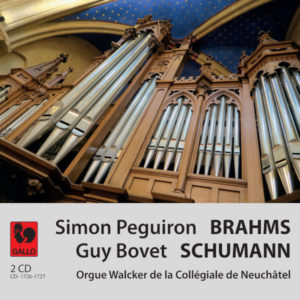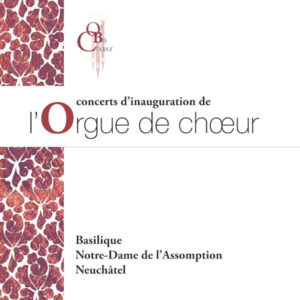Extraits / Excerpts
Franck: Grande pièce symphonique, Op. 17 - Pièce héroïque - Cantabile - Pastorale, Op. 19 - Philippe Laubscher, Organ
César FRANCK: Grande pièce symphonique, Op. 17, FWV 23: I. Andantino serioso – Allegro non troppo maestoso – II. Andante – III. Allegro – IV. Andante – V. Allegro non troppo e maestoso – VI. Beaucoup plus largement que précédemment – Pièce héroïque, FWV 37 – Cantabile, FWV 36 – Pastorale in E Major, Op. 19, FWV 31.
Philippe Laubscher at the organ of the French Church in Bern.
The Organ Works of César Franck (1822-1890)
César Franck, deeply familiar with the great classical composers such as Bach, Mozart, Gluck, and Beethoven, made his contemporaries rediscover that the organ is not only an instrument for picturesque and, all too often, ludicrous effects, but can also embody grandeur, lyricism, and spirituality. For this reason, Franck is undoubtedly the greatest organ master of the 19th century.
In 1859, César Franck inaugurated the grand Cavaillé-Coll organ at the Basilica of Sainte-Clotilde in Paris, where he was the appointed organist. For this instrument, he composed between 1860 and 1862 his Six Pièces pour Grand Orgue, which includes the Grande Pièce Symphonique Op. 17 and the Pastorale Op. 19.
The Grande Pièce Symphonique, Op. 17
The Grande Pièce Symphonique, which allows the player to fully explore the tonal palette of the instrument, is a piece Franck often referred to by paraphrasing Berlioz: “The orchestra is a king, but the organ is the Pope.” This work is the first example of the organ symphony, a genre later embraced by composers like Vierne and Widor. Its form mirrors that of the orchestral symphony: introduction, allegro, andante, scherzo, and finale, all seamlessly linked without interruption. The opening allegro in F-sharp minor follows an andante serioso, built on two themes. Unusually, the scherzo is inserted into the middle of the andante. All the previously introduced themes briefly reappear, leading to a radiant finale, where the opening allegro theme returns, now in the major key.
The Pastorale, Op. 19
The three-part Pastorale is one of the finest works of its kind. Dedicated to “his friend, Mr. Aristide Cavaillé-Coll,” the work justifies its title through a poetic atmosphere, which is highlighted by the careful use of the organ’s stops.
The Cantabile and Pièce Héroïque
The Cantabile and Pièce Héroïque are part of a set of three pieces composed for the inauguration of the large organ Cavaillé-Coll had just built in 1878 at the Trocadéro Palace.
The Cantabile unfolds in a lyrical and poetic atmosphere. The main theme, played on the trumpet stop, is interspersed with episodes on the foundation stops, creating a dialogue between these two distinctive organ tones. The trumpet moves from the soprano range to the tenor, eventually leading to a canon between soprano and bass. The piece concludes with serenity and simplicity.
The Pièce Héroïque is based on two themes: the first is lyrical and impassioned, unfolding over a background of rhythmic chords; the second is a serene chorale in the major key. The piece builds through a sweeping crescendo, culminating in a grandiose harmonization of the chorale, which requires the full power of the organ.
Philippe Laubscher, born in 1936, is the appointed organist of the Predigerkirche (French-speaking Church) in Bern. After training as an electrical engineer, he devoted himself to the organ, studying with André Bourquin, André Luy, Jiri Reinberger, and Jean-Jacques Grunenwald. In the latter’s class, he was awarded the Premier Prix de Virtuosité at the Geneva Conservatory. Alongside his teaching roles at the conservatories of Bern and La Chaux-de-Fonds, he maintains an active career as a recitalist in Switzerland and abroad.
- Categories
- Composers
- Interprets
- Booklet












